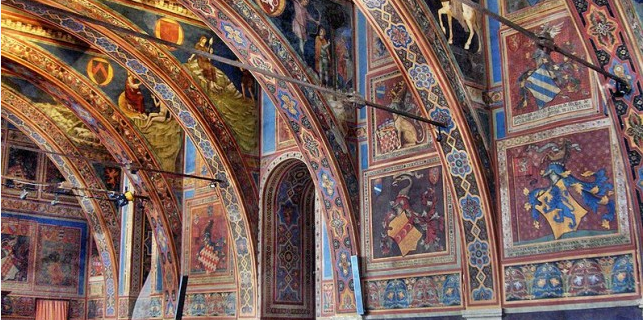The Humble Art of the Nativity Crèche in Umbria
Welcome to the last monthly Italy Blogging Roundtable of 2016 (thank goodness…let’s turn the page on this year)! The theme this month is “Home”, so take a look at posts by Georgette Jupe, Kate Bailward, Jessica Spiegel, Melanie Renzulli, Alexandra Korey, Gloria, Laura Thayer, and Michele Fabio. (If you missed the previous months, take a look here.) Welcome back to our holiday table…come pull up a chair and join in on the conversation!
PS: I wrote a little ditty about “home” years ago for Gloria, so if you want a strict interpretation of this month’s theme, feel free to take a look. Today, I am going with a more loose interpretation of the theme. It is what it is.
Nothing says home to me more than where you spend the holidays, gathered with the people you love, eating and chatting and generally being reminded of why you both love and irritate the dickens out of each other. In all my homes over the years, this has been done beneath the Christmas tree, but most Umbrian homes–and businesses, churches, and public spaces—are adorned during the holiday season with the traditional Nativity scene or crèche. Some are a simple crib including the Holy Family, perhaps beneath a thatched roof with an ox and ass thrown in, but much more often they are sprawling, elaborate scale models representing village and country life, often with tens–if not hundreds–of figurines, moving mechanical parts, small glowing “fires” and running fountains, and artistic lighting.

A secondary countryside portion of the sprawling Nativity scene at Rivotorto. The empty rectangular boxes will have fields of wheat planted in them come Christmas. Oh, and there will be snow on the hilltops.
You can hardly take a step during the month of December in Umbria without coming across a Nativity scene tucked in the most unlikely of places (there was one next to my bank teller’s window this morning), but perhaps even more delightful than the finished product is watching the painstaking labor behind the construction and assembly of one of these humble and transient works of art.

Enzo, Franco, and Alberto: the Three Wise Guys behind Rivotorto’s historic Nativity scene. I made them pose for the camera. Can you tell?
Just ask Franco, Alberto, and Enzo. This winning threesome has been the creative and logistical team behind the massive Nativity scene which fills the area around Rivotorto’s Tugurio shrine for the last thirty-eight years. The first home of Saint Francis and his disciples, the Sacro Tugurio (or sacred shed) was occupied by Francis and his followers from 1208-1211, where they lived and worshipped in this rough stone hut and here began organizing what would become Francis’ order. In 1211, the group was granted use of the nearby Porziuncola in Santa Maria degli Angeli from the Benedictines, and the Sacro Tugurio was abandoned only to become a site of pilgrimage in the following centuries.
And guess what? It’s also the perfectly picturesque backdrop to one of the area’s most lovely Nativity scenes every year. I stopped by one morning to see how work was moving along, and was able to watch the “artists” at work and chat about good old times. Times when the Nativity scene was actually outside—this before the threesome were retired—so work went on in rain and snow, beginning after dinner and going late into the night. The time about 15 years ago when the creche mysteriously caught fire (cryptic mentions of competing Nativity scene teams and significant looks are exchanged here), and the parish priest kicked them back outside for a couple of years. The year of the earthquake, when the whole church was closed for the season. That one year that Franco didn’t work on the creche because of (as the three will sheepishly admit if you press them) irreconcilable creative differences. But he was back on board the following Christmas.
Work begins at the end of November and proceeds with due ponderance and frequent coffee breaks for about a month (the creche is open to the public from 24 December through the first week of January). The threesome work without a master plan, beginning with the central Nativity crib—emphatically underlined by all three as the most important and beautiful section of the creche—and gradually moving towards the outside of the surrounding model countryside. All the buildings are made by hand, and new elements are added each year; the oldest piece is a terra-cotta team of oxen with a plowing farmer, which is over 40 years old. The scene is built up with moss and life greenery, sand and gravel roads, dozens of wooden buildings and structures, water elements and fields of sod and wheat.

A water element. Since a short caused a fire about 15 years ago, the team keeps water and electricity as far from each other as possible.

The B-list characters are the last to make a cameo appearance, filling in any holes during the final retouches.
After the holidays, the team breaks the scene down again, repairs and packs away the pieces, and begins laboring over new buildings and elements for the following year, when they will meet up, have a leisurely caffè, and start work all over again.

These oxen and their farmer have been in the Rivotorto Nativity scene since the beginning. They are older than I am.
Read the posts, leave comments, share them with your friends – and tune in next month for another Italy Blogging Roundtable topic!











